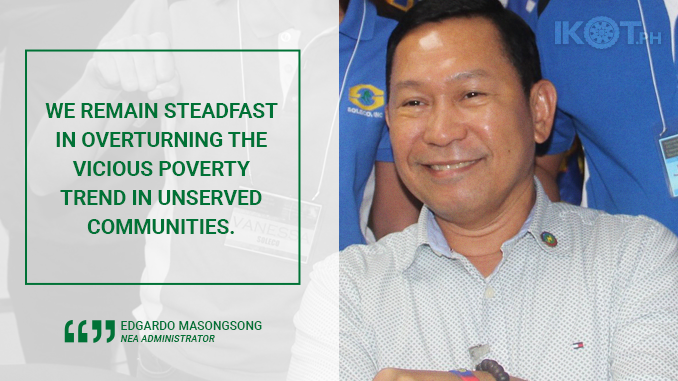The number of Filipino households connected to electricity has increased significantly in the first two months of 2018, despite the many factors hindering the implementation of the rural electrification program, the National Electrification Administration (NEA) has reported.
The NEA through its Information Technology and Communications Services Department (ITCSD) has monitored 93,324 new consumer connections or 20 percent of the 460,000 target for 2018, bringing the overall level of energization at 12,279,816.
Of the new connections recorded during the first two months, 34,580 are located in Mindanao, 34,356 in Luzon, and 24,388 in Visayas, the NEA-ITCSD said in its Status of Energization Report covering the first two months of 2018.
Yet despite the improvement in household connections, NEA Administrator Edgardo Masongsong said there is a lot of work that still needs to be done to close the electricity access gap in rural and remote communities.
“While we put a lot of premium on member-consumer-owners and the promotion of their rights as electricity end-users, we remain steadfast in overturning the vicious poverty trend in unserved communities, especially in Mindanao, via electrification with the partnership of electric cooperatives,” Masongsong said.
The NEA chief said there are 19,740 sitios that remain without electricity. Majority of these unenergized are in Mindanao (8,535), then Luzon (6,541), and Visayas (4,664).
To fully implement the rural electrification program before President Rodrigo Duterte’s term ends, the agency needs at least PhP 25 billion, noting that the average cost to energize a sitio is PhP 1.4 million.
Masongsong said electrifying them is no easy task as many of these sitios are located in far-flung and isolated areas, which are harder to get to.
He also cited difficult terrain, right-of-way issues, unstable peace and order conditions in some areas, natural calamities, and administrative constraints as key challenges in the implementation of rural electrification.
Thus, the NEA proposes a set of measures and strategies to be taken to accelerate the attaintment of total electrification of the country. These measures include the issuance of an executive order aimed at accelerating the energization of unserved, underserved and unviable areas; and amendments to the existing department circular on Qualified Third Party (QTP) policy.
The agency also proposes to continue the subsidy allocation for Sitio Electrification (SEP), Barangay Line Enhancement (BLEP) and Household Electrification Programs, consider the option of bringing the households to the last tapping pole, streamline and simplify the administrative requirements and processes, and allow private sector participation in off-grid, unviable areas only through QTP.
Under SEP Phase 2, the NEA, together with the 121 ECs nationwide, has energized some 1,474 sitios while 409 more are nearing completion. Of the 1,474 electrification projects, 563 went to Mindanao, 439 to Luzon, and 472 to Visayas, bringing down the unenergized sitios to 18,266.
The Rural Electrification Program, since its inception in 1969, has successfully energized 78 provinces, 90 cities, 1,385 municipalities, 36,051 barangays, and 121,513 sitios, benefiting 12.280 million households or nearly 60 million Filipinos as of February 2018.

